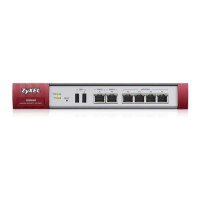Chapter 18 Route
ZyWALL Series CLI Reference Guide
171
The following table describes the commands available for policy route. You must use the configure
terminal
command to enter the configuration mode before you can use these commands.
Table 82 Command Summary: Policy Route
COMMAND DESCRIPTION
[no] bwm activate
Globally enables bandwidth management. You must globally activate
bandwidth management to have individual policy routes or application
patrol policies apply bandwidth management. The no command globally
disables bandwidth management.
policy {policy_number | append |
insert policy_number}
Enters the policy-route sub-command mode to configure, add or insert a
policy.
[no] auto-destination
When you set tunnel as the next-hop type (using the next-hop tunnel
command) for this route, you can use this command to have the Zyxel
Device use the local network of the peer router that initiated an incoming
dynamic IPSec tunnel as the destination address of the policy instead of
what you configure by using the destination command. The no
command disables the setting.
[no] auto-disable
When you set interface or trunk as the next-hop type (using the next-
hop interface or next-hop trunk command) for this route, you can
use this command to have the Zyxel Device automatically disable this
policy route when the next-hop’s connection is down. The no command
disables the setting.
conn-check {FQDN | addr |
activate}
Turns on the connection check to the gateway identified by its FQDN or IP
address.
[no] deactivate
Disables the specified policy. The no command enables the specified
policy.
[no] description description
Sets a descriptive name for the policy. The no command removes the
name for the policy.
[no] destination
{address_object|any}
Sets the destination IP address the matched packets must have. The no
command resets the destination IP address to the default (any). any
means all IP addresses.
[no] dscp {any | <0..63>}
Sets a custom DSCP code point (0~63). This is the DSCP value of incoming
packets to which this policy route applies. any means all DSCP value or no
DSCP marker.
[no] dscp class {default |
dscp_class}
Sets a DSCP class. Use default to apply this policy route to incoming
packets that are marked with DSCP value 0. Use one of the pre-defined
AF classes (including af11~af13, af21~af23, af31~af33, and af41~af43) to
apply this policy route to incoming packets that are marked with the
DSCP AF class.
The “af” entries stand for Assured Forwarding. The number following the
“af” identifies one of four classes and one of three drop preferences. See
Assured Forwarding (AF) PHB for DiffServ on page 175 for more details.
dscp_class can set cs0~cs7 too.
dscp-marking <0..63>
Sets a DSCP value to have the Zyxel Device apply that DSCP value to the
route’s outgoing packets.
dscp-marking class {default |
dscp_class}
Sets how the Zyxel Device handles the DSCP value of the outgoing
packets that match this route. Set this to default to have the Zyxel
Device set the DSCP value of the packets to 0. Set this to an “af” class
(including af11~af13, af21~af23, af31~af33, and af41~af43) which stands
for Assured Forwarding. The number following the “af” identifies one of
four classes and one of three drop preferences. See Assured Forwarding
(AF) PHB for DiffServ on page 175 for more details.
dscp_class can set cs0~cs7 too.

